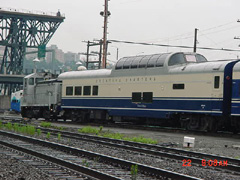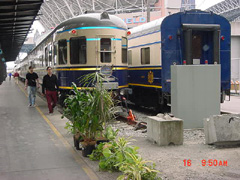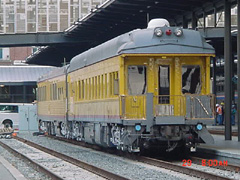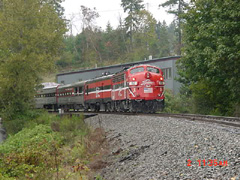
NATIONAL RAILWAY BUSINESS CAR SERVICES
DIRECTOR: Louis Charles Hoffman Alloin
![[Previous Page]](http://www.atdlines.com/images/previous.gif)
| |||||||

|

|

|

|

BUSINESS CONDUCT AND DIRECTORS CODE OF ETHICS
ATD LINES SAFETY DETERMINATIONS
ATD LINES believe every accident or injury is preventable. ATD LINES determination is to operate in an environment free of accidents and injuries. ATD LINES will achieve this determination through: Culture: ATD LINES highest determination of priorities and provides continuous self-examination as to the effectiveness of commitment to safety process and performance.
Work Environment: Resources and tools that are safe and accident-free where all known hazards will be eliminated or safeguarded.
Work Practices and Training: All personnel that make safety essential to the tasks and obligation to safety performance.
Empowered Work Force: All personnel, that take responsibility for safety seriously, the safety of fellow personnel, and the rail line communities and corporations in which ATD LINES is dedicated to serve.
MAINTENANCE OF WAY OPERATING RULESAtlantic, Eastern, Central, Mountain and Pacific North American Continental Time
Revised 04-01-2006 In Effect at 0001
Table of Contents1.0 General Responsibilities ... 1-1 1.1 Safety ... 1-1 1.1.1 Maintaining a Safe Course ... 1-1 1.1.2 Alert and Attentive ... 1-1 1.1.3 Accidents, Injuries, and Defects ... 1-1 1.1.4 Condition of Equipment and Tools ... 1-1 1.1.5 Inspection After Derailment ... 1-1 1.2 Personal Injuries and Accidents ... 1-1 1.2.1 Care For Injured ... 1-1 1.2.2 Witnesses ... 1-2 1.2.3 Equipment Inspection ... 1-2 1.2.4 Mechanical Inspection ... 1-2 1.2.5 Reporting ... 1-2 1.2.6 Statements ... 1-2 1.2.7 Furnishing Information ... 1-3 1.3 Rules ... 1-3 1.3.1 Rules, Regulations, and Instructions ... 1-3 1.3.2 General Orders ... 1-3 1.3.3 Circulars, Instructions, and Notices ... 1-3 1.4 Carrying Out Rules and Reporting Violations... 1-4 1.5 Drugs and Alcohol ... 1-4 1.6 Conduct ... 1-4 1.6.2 Notification of Felony Conviction ... 1-4 1.7 Altercations ... 1-4 1.8 Appearance... 1-4 1.9 Respect of Railroad Company ... 1-4 1.10 Games, Reading, or Electronic Devices ... 1-5 1.11 Sleeping ... 1-5 1.11.1 Napping ... 1-5 1.12 Weapons ... 1-5 1.13 Reporting and Complying with Instructions ... 1-5 1.14 Employee Jurisdiction ... 1-5 1.15 Duty—Reporting or Absence ... 1-6 1.16 Subject to Call ... 1-6 1.17 Hours of Service Law ... 1-6 1.18 Unauthorized Employment ... 1-6 1.19 Care of Property ... 1-6 1.20 Alert to Train Movement ... 1-6 1.21 Occupying Roof ... 1-6 1.22 Not Permitted on Equipment ... 1-6 1.23 Altering Equipment ... 1-7 1.24 Clean Property ... 1-7 1.25 Credit or Property ... 1-7 1.26 Gratuities ... 1-7 1.27 Divulging Information ... 1-7 1.28 Fire ... 1-7 1.33 Loading Freight Cars ... 1-7 1.34 Flat Spots ... 1-8 1.35 Dump Doors ... 1-8 1.44 Duties of Train Dispatchers ... 1-8 1.45 Duties of Bridge-tenders ... 1-8 1.46 Duties of Yard-masters ... 1-8 1.48 Encroachment ... 1-8 2.0 Railroad Radio Rules ... 2-1 2.1 Transmitting ... 2-1 2.2 Required Identification ... 2-1 2.3 Repetition ... 2-1 2.4 Ending Transmission ... 2-1 2.6 Communication Not Understood or Incomplete. 2-2 2.7 Monitoring Radio Transmissions ... 2-2 2.8 Acknowledgment ... 2-2 2.9 Misuse of Radio Communications ... 2-2 2.10 Emergency Calls ... 2-2 2.11 Prohibited Transmissions ... 2-3 2.12 Fixed Signal Information ... 2-3 2.13 In Place of Hand Signals ... 2-3 2.14 Mandatory Directive ... 2-3 2.14.1 Verbally transmitting and repeating Mandatory Directives ...2-4 2.15 Phonetic Alphabet ... 2-4 2.16 Assigned Frequencies ... 2-4 2.17 Radio Testing ... 2-4 2.18 Malfunctioning Radio ... 2-4 2.19 Blasting Operations ... 2-4 2.20 Internal Adjustments ... 2-4 2.21 Requirement for Roadway Workers ... 2-4 3.0 Standard Time ... 3-1 3.1 Standard Clocks ... 3-1 3.2 Watch Requirement ... 3-1 3.3 Time Comparison ... 3-1 4.0 Timetables ... 4-1 4.1 New Timetable ... 4-1 4.1.1 Notice of New Timetable ... 4-1 4.2 Special Instructions ... 4-1 4.3 Timetable Characters ... 4-1 5.0 Signals and Their Use ... 5-1 5.1 Signal Equipment ... 5-1 5.2 Receiving and Giving Signals ... 5-1 5.2.1 Looking for Signals ... 5-1 5.2.2 Signals Used by Employees ... 5-1 5.2.3 Flagging Kits 5.3 Hand and Radio Signals ... 5-1 5.3.1 Hand Signals ... 5-1 5.3.2 Giving Signals ... 5-2 5.3.3 Signal Disappearance ... 5-2 5.3.4 Signal to Stop ... 5-2 5.3.5 Explain Stop Signal ... 5-2 5.3.6 Radio and Voice Communication ... 5-2 5.3.7 Radio Response ... 5-2 5.4 Flags for Temporary Track Conditions ... 5-3 • Information in the files or in other privileged or confidential reports of the ATD LINES or operating railroad concerning accidents or personal injuries may be given only to an authorized Representative. 1.2.7 Furnishing Information Personnel must not withhold information, or fail to give all the facts to those Authorized to receive information regarding unusual events, accidents, personal Injuries, or rule violations.1.3 Rules 1.3.1 Rules, Regulations, and Instructions Safety Rules: Personnel must have a copy of, be familiar with, and comply with all Safety rules issued in a separate book or in another form. Maintenance of Way Operating Rules: Personnel governed by these rules must Have a current copy they can refer to while on duty. Hazardous Materials: Personnel who in any way handle hazardous materials must Have a copy of the instructions or regulations for handling these materials. Personnel Must be familiar with and comply with these instructions or regulations. Timetable/Special Instructions: Personnel whose duties are affected by the Timetable/special instructions must have a current copy they can refer to while on duty. Training: Personnel must be familiar with and obey all rules, regulations, and Instructions and must attend required classes. Personnel must pass the required Examinations. Explanation: Personnel must ask their supervisor for an explanation of any rule, regulation or instruction unsure of. Issued, Cancelled or Modified: Rules may be issued, cancelled, or modified by track-bulletin, general order, or special instructions. Engineering Instructions: Personnel governed by the Engineering Instructions must be familiar with and comply with all their provisions; additionally, a copy of Engineering Instruction No. 1 must be available for reference while on duty. NOTE: When amendments are made to the Maintenance of Way Operating Rules and Engineering Instruction No. 1, employees must have a copy of the general order with their rule books, make notation of the change in their rule book, or obtain a copy the revised page.1.3.2 General Orders General orders:• Are numbered consecutively. • Are issued and cancelled by the designated manager. • Contain only information and instructions related to rules or operating practices. • Replace any rule, special instruction, or regulation that conflicts with the general order. Before beginning each day’s work or trip, trainmen, engine-men, and any others whose duties require, must review general orders that apply to the territory they will work on. 1.3.3 Circulars, Instructions, and Notices Circulars, instructions, notices, and other information are issued and cancelled by the designated manager. Before beginning each day’s work or trip, trainmen, engine-men, and any others whose duties require, must review those that apply to the territory they will work on.1.4 Carrying Out Rules and Reporting Violations Personnel must cooperate and assist in carrying out the rules and instructions. They must promptly report any violations to the proper supervisor. They must also report any condition or practice that may threaten the safety of trains, passengers, or personnel, and any misconduct or negligence that may affect the interest of ATD LINES or operating railroad.1.5 Drugs and Alcohol The use or possession of alcoholic beverages while on duty or on company property is prohibited. Personnel must not have any measurable alcohol in their breath or bodily fluids when reporting for duty, while on duty, or while on ATD LINES or operating railroad property. The use or possession of intoxicants, over-the-counter or prescription drugs, narcotics, controlled substances, or medication that may adversely affect safe performance is prohibited while on duty or on ATD LINES or operating railroad property, except medication that is permitted by a medical practitioner and used as prescribed. Personnel must not have any prohibited substances in bodily fluids when reporting for duty, while on duty, or while on ATD LINES or operating railraod property. 1.6 Conduct Personnel must not be:1. Careless of the safety of themselves or others 2. Negligent 3. Insubordinate 4. Dishonest 5. Immoral 6. Quarrelsome 7. Discourteous Any act of hostility, misconduct, or willful disregard or negligence affecting the interest of ATD LINES or its personnel is cause for dismissal and must be reported. Indifference to duty, or to the performance of duty, will not be tolerated. 1.6.2 Notification of Felony Conviction The conduct of any Personnel leading to conviction of any felony is prohibited. Any Personnel convicted of a felony must notify the proper authority of that fact within 48 hours after the Personnel receives notice of the conviction.1.7 Altercations Personnel must not enter into altercations with each other, play practical jokes, or wrestle while on duty or on ATD LINES or operating railroad property.1.8 Appearance Personnel reporting for duty must be clean and neat. Personnel must wear the prescribed uniform when required.1.9 Respect of Railroad Company Personnel must behave in such a way that the railroad will not be criticized for their actions.6.3.3 Visual Detection of Trains Authority or protection is not required when using visual detection of trains as outlined below.STATEMENT OF ON-TRACK SAFETYA lone worker using individual train detection or a lookout using train approach warning to establish on-track safety must complete this form prior to fouling a track. To complete this form:1. Provide the following information: Name of Lone Worker/Lookout: ____________________ Date: _______________ Division: ___________________ Subdivision:_____________________________________ Location: From MP___________ to MP ______________ Designated Place of Safety: _______________________ Method of Warning: ______________________________ Time form completed: ____________________________ 2. In the table below, place an X in the box adjacent to the maximum authorized speed of trains at the location specified above. Observe the minimum required distance between the approaching train and the employee(s) when the place of safety has been reached. Note: When the maximum authorized speed is not shown on the form, use the next higher speed. A. Lone Workers Lone workers using individual train detection must complete the form entitled, "Statement of On-Track Safety" prior to fouling a track. The completed form must be in the employee’s possession when used to establish on track safety. Each personnel providing protection for a work group, and each lone worker, shall maintain immediate access to a working radio, which can be a portable radio capable of monitoring transmissions from train movements in the vicinity.Lone Worker ResponsibilitiesLone workers must: • Identify a place of safety prior to fouling a track. • Position themselves in a predetermined place of safety at least 15 seconds prior to the arrival of the train moving at maximum authorized speed as indicated in the Statement of On-Track Safety. Conditions for Use Lone workers may perform minor work or a routine inspection using individual train detection when they meet all of the following conditions: • The work will not affect the movement of trains. • The lone worker is able to visually detect the approach of a train moving at maximum authorized speed and position themselves in a predetermined place of safety at least 15 seconds prior to the arrival of the train as indicated on the Statement of On-Track Safety. • Power-operated tools or roadway maintenance machines are not in use within hearing distance. • The ability to hear and see approaching trains and other on-track equipment is not impaired by background noise, lights, precipitation, fog, a passing train or other physical condition. • The work is performed outside the limits of a control point or a remotely controlled hump yard facility. Automatic inter-locking are not control points. B. Lookouts Lookouts must complete the form entitled "Statement of On-Track Safety" prior to anyone fouling the track. The completed form must be in personnel possession when used to establish on-track safety. Work groups may use a lookout to perform minor work or a routine inspection using train approach warning. Lookout Responsibilities Lookouts must adhere to the following:• Be trained and rules qualified. • Identify a place of safety where they and personnel they are protecting can go hen a train approaches. • Communicate the place of safety to the other personnel prior to the track being ouled. • Devote their full attention to detecting the approach of trains and warning employees. • Warn employees and have them positioned in a predetermined place of safety at east 15 seconds prior to the arrival of the train moving at maximum authorized peed as indicated in the Statement of On-Track Safety. • Use a method to warn personnel of the approach of a train or on-track equipment hat: - Is distinctive, clear and unquestionable. - Does not require employees to be looking in any particular direction. - Can be detected by employees regardless of noise or work distractions. - Is identified in the job safety briefing. Personnel who depend upon a lookout for protection must always remain in a position that allows them to receive warnings communicated by the lookout. Conditions for Use Work groups may use a lookout to perform minor work or a routine inspection using train approach warning when they meet all of the following conditions: • The work will not affect the movement of trains. • Lookouts must be able to visually detect the approach of a train moving at maximum authorized speed. They must position themselves and the members of the work group in a predetermined place of safety at least 15 seconds prior to the arrival of the train as indicated on the Statement of On-Track Safety. • The ability to communicate a warning to all members of the work group upon the approach of trains and other on-track equipment is not impaired by background noise, lights, precipitation, fog, a passing train or other physical condition. 6.4 Reverse Movements Make reverse movements on any main track at restricted speed and only within the limits on-track equipment has authority to occupy the track. Restricted Speed Authorized Direction Reverse [Diagram A. Pending]6.5 Handling Cars Ahead of Engine When cars or engines are shoved and conditions require, a crew member must take an easily seen position on the leading car or engine, or be ahead of the movement, to provide protection. Cars or engines must not be shoved until the equipment operator knows who is protecting the point of the movement and how protection will be provided. Cars or engines must not be shoved to block other tracks until it is safe to do so. When cars are shoved on a main track or controlled siding in the direction authorized, movement must not exceed: • 20 MPH for freight trains and on-track equipment. • Maximum timetable speed for snow service unless a higher speed is authorized by employee in charge.6.5.1 Remote Control Movements Remote control movements are considered "shoving" movements, except when the remote control operator controlling the movement is riding the leading engine in the direction of movement. Before initiating movement, the remote control operator or a crew personnel must be in position to visually observe the direction the equipment moves. Relief of Providing Protection The remote control operator is relieved from the requirement to stop within half the range of vision for movements with engine on leading end when:1. The remote control zone has been activated. 2. Switches/derails are known to be properly lined. 3. Track(s) within the zone are known to be clear of other trains, engines, railroad cars, men or equipment fouling track. This process must repeated each time the remote control zone is activated. 6.7 Remote Control Zone A. Entering Remote Control Zone Before entering a remote control zone, all employees that are not part of the remote control crew must determine whether the zone is activated. Personnel may receive this information from the remote control operator, other authorized employee, or special instructions.Glossary AbbreviationsUse only the following abbreviations: Use the normal abbreviations for names of months. ABS: See Automatic Block Signal System. Absolute Block: A length of track that no train is permitted to enter while the track is occupied by another train. Absolute Signal: A block or interlocking signal without a number plate, or designated by an A marker. Adjacent Tracks: Two or more tracks with track centers spaced less than 25 feet apart. Automatic Block Signal System/ABS: A series of consecutive blocks governed by block signals, cab signals, or both. The signals are activated by a train or by certain conditions that affect the block use. Automatic Switch: A switch that, when movement over the switch is complete, will automatically return to its normal position. Block: A length of track: • Between consecutive block signals. • Between a block signal and the end of block system limits. • In ATC limits the use of which is governed by cab signals and/or block signals. Block Signal: A fixed signal at the entrance of a block that governs trains entering and using that block. Block System: A block or series of consecutive blocks within ABS, ACS, CTC, or interlocking limits. Cars: Railroad cars. Centralized Traffic Control/CTC: A block system that uses block signal indications to "authorize train movements". Conductor: Personnel in charge of train or yard movement. Control Operator: Personnel assigned to operate a CTC or interlocking control machine or authorized to grant track permits. Control Point: The location of absolute signals controlled by a control operator. Controlled Siding: A siding within CTC or interlocking limits where a signal indication authorizes the siding’s use. Rules applicable in CTC apply on these sidings. Controlled Signal: An absolute signal controlled by a control operator. Crossings at Grade: Crossings that intersect at the same level. Crossover: A combination of two switches that connect two adjacent tracks. CTC: See Centralized Traffic Control. Current of Traffic: The movement of trains in one direction on a main track as specified by the rules. Distant Signal: A fixed signal outside a block system that governs the approach to a block signal, interlocking signal, or switch point indicator. A distant signal does not indicate conditions that affect track use between the distant signal and block or interlocking signals or between the distant signal and switch point indicator. Distant signal identified by "D". Double Track: Two main tracks where the current of traffic on one track is in a specified direction and in the opposite direction on the other. Dual Control Switch: Power-operated switch, "moveable point frog", or derail that can also be operated by hand. Effective Locking Device: When used in relation to a manually operated switch or "Derail", a lock that can be locked or unlocked only by the craft or group personnel applying the lock. Electric Switch Lock: An electrically controlled lock that restricts the use of a hand-operated switch or derail. Employee in Charge/EIC: A rules qualified MW personnel who is assigned the duty of being responsible for the protection and direction of his/her self and his/her co-personnel in any engineering work activity. Engine: A unit propelled by any form of energy or more than one of these units operated from a single control. Engines are used in train or yard service. Rules that apply to engines also apply to cab control cars. Engineer: Also includes student personnel engineers, firemen, and hostlers (See also Remote Control Operators). Equipment: Railroad equipment. Escort: Personnel familiar with the territory and assigned by personnel in charge to assist the movement of equipment operated by employees, contractors, or other outside personnel unfamiliar with the territory . Fixed Signal: A signal that is fixed to a location permanently and that indicates a condition affecting train movement. Flagger: A person providing warning for malfunctioning crossing devices. Flagman: Any rules qualified employee providing flag protection. Foreman: Personnel in charge of work. Foul of Track: Within four feet of the nearest rail of a track. General Track Bulletin: A notice containing track bulletin restrictions and other conditions affecting train movement. |
![[Email Us]](http://www.atdlines.com/images/mailbutn.gif)
![[Return to Top]](http://www.atdlines.com/images/up.gif)
![Power By ETS]](http://www.atdlines.com/motion/train6.gif)
![Power By ETS]](http://www.atdlines.com/images/power.gif)
